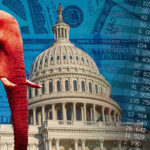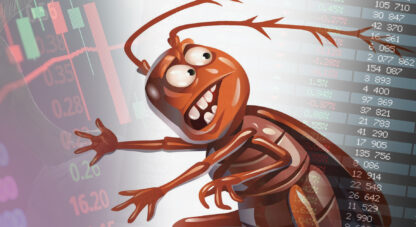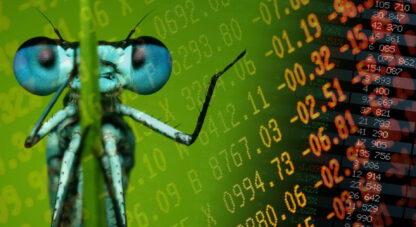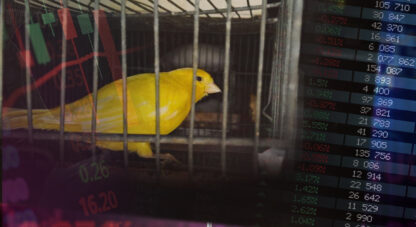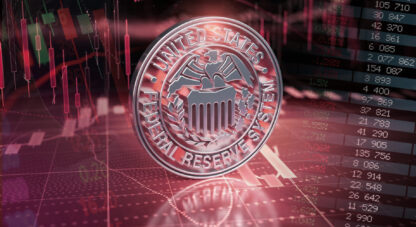It cannot be overstated: Bubbles are of paramount importance – for markets, finance more generally, economies, and social and geopolitical stability. Two U.S. bursting episodes over the past twenty years would seem to make this proposition indisputable. I would add that Bubble Dynamics have never been more pertinent than they became over the past year. Apply monetary stimulus to a historic financial Bubble and you’re asking for serious trouble: The Story of a Perilous 2019.
Yet “Bubble” these days has no part in conventional analysis or dialogue – for central bankers, economists or market pundits. To even utter the word on CNBC or Bloomberg would suggest one is hopelessly detached from reality. From my vantage point, bullishness and New Paradigm thinking these days rivals that of the early-2000 peak. Today’s faith in central banking is unrivaled – the willingness to embrace egregious excess unmatched.
To summarize the 2019 policy backdrop in one word: capitulation. It was to be a year of monetary policy normalization. The new Fed chairman was to finally return policy rates to a more reasonable level. After leaving rates near zero for seven years, the Fed belatedly took a baby step in December 2015. A full year went by before mustering the courage for a second cautious step. And a year full later (December 2017) rates were still at 1.00%.
Policy rates were only up to 1.25% to 1.50% when Powell took the reins. Having delayed the process much too long, “normalization” was not going to go smoothly. Rates were taken to 2.25% (to 2.5%) by the end of 2018, and the wheels almost came off. Powell’s January 4th dovish U-turn essentially ended any notion of rate normalization. Avoiding market instability was the priority – and celebratory markets took full advantage. In 2019, the odds central bankers would ever actually tighten monetary conditions became exceedingly low.
To accurately comprehend 2019 demands attention to key Bubble Dynamics. First of all, to employ monetary stimulus in the late stage of a Bubble ensures instability. Conventional thinking – both in policy circles and the markets – was that with limited ammunition central bankers should utilize stimulus early and aggressively. Late-cycle Bubbles, by their nature, connote financial and economic fragilities.
There are at the same time powerfully-entrenched inflationary biases – including expansive infrastructures fostering higher asset prices. Policymaker focus on bolstering system resiliency ensures a precarious extension of “Terminal Phase” excess – in Credit, speculation, speculative leverage, risk intermediation, malfunctioning markets, resource misallocation and associated financial and economic maladjustment.
In the late phase of history’s greatest global financial Bubble, there’s the thinnest of lines between the onset of crisis and rip-roaring bull markets.
On Thursday, January 3rd, Goldman Sachs Credit default swap (5yr CDS) prices surged 19 to 131 bps – the high since March 2016 and the largest one-day move since 2013. In the currency markets, a “flash crash” saw stunning moves including an 8% intraday move in the Japanese yen/Australian dollar. Dislocation had begun to unfold across global derivatives markets. Panic buying saw Treasury yields sink 15 bps, pushing the collapse from November 8th highs (3.24%) to 70 bps. Corporate Credit spreads were blowing out, especially in junk debt. Deleveraging dynamics were global. For example, the spread between 10-year German bunds and the European periphery (i.e. Italy and Portugal) widened markedly. A major de-risking/deleveraging event had gathered momentum. Equities were under pressure, with the DJIA sinking 660 points during that fateful session.
The following day Chairman Powell joined Janet Yellen and Ben Bernanke for a panel discussion at a meeting of the American Economic Association. Only two weeks since the Fed’s December 19th rate increase and press conference, Powell’s comments were not expected to be monetary policy-focused. But the Chairman pulled out prepared comments and orchestrated a dramatic “dovish U-turn”: “…Policy is very much about risk management.” “We will be patient as we watch to see how the economy evolves…” “…Always prepared to shift the stance of policy and to shift it significantly if necessary…” “We will be prepared to adjust policy quickly and flexibly and to use all of our tools to support the economy…”
Despite economic resilience and a 3.9% unemployment rate, the Fed was prepared to add monetary stimulus to support the markets. The DJIA rallied 747 points January 4th on Powell’s comments. It was a prescient market move signaling the Year of Monetary Disorder.
M2 “money” supply surged $1.024 TN, or 7.1%, in 2019, easily surpassing 2016’s record $880 billion expansion. This was 65% ahead of average annual M2 growth over the preceding decade. Moreover, Institutional Money Fund Assets (not included in M2) jumped $407 billion, or 21.9%, up from 2018’s $27 billion increase – and the strongest money market fund expansion since 2007. In a year of strong Credit growth, total third quarter U.S. Credit (Non-Financial, Financial and Foreign U.S. borrowings) jumped a nominal $1.075 TN (from Fed’s Z.1), the strongest quarterly gain since Q4 2007.
2019 was the year of “the everything rally;” FOMO – fear of missing out – the year’s amalgamation of Greed and Fear. Stocks, Treasuries, corporate Credit at home and abroad. Don’t ask why – just buy, and the more levered the better. With an enduring U.S. economic expansion, the S&P500 returned 32.61%. With Germany’s economy stagnating, the DAX index returned 25.48%. Fighting persistent recessionary forces, Italy’s MIB index returned a prosperous 33.80%. Recession or, in the case of the U.S., stagnant earnings were irrelevant.
After trading to a January high of 2.79%, 10-year yields sank below 1.50% in August. By late-July, the S&P500 had already gained more than 20%, with the Nasdaq100 up 26% and the Semiconductors surging almost 40%. Who was wrong, booming stocks or booming safe haven bonds? Monetary Disorder made everything seem right.
In a replay of the fall of 2007, Treasuries and safe haven government bonds rallied robustly in the face of bubbling equities prices. There was certainly a short squeeze element bolstering the marketplace, as hedges against Fed “normalization” were unwound. But, mainly, safe havens could monitor Bubble excess in the U.S. and a faltering Chinese Bubble and enjoy high confidence that global central bankers would be soon following through on promises to do “whatever it takes.” Lower market yields were instrumental in fostering risk market excess, and the greater the Bubbles inflated the more the safe havens anticipated rate cuts and more QE.
Treasuries, bunds, Swiss bonds, and Japan’s JGBs were transformed into the most enticing financial instruments imaginable. Central banks were essentially guaranteeing they would perform well. And in the event of global instability they would provide spectacular returns. A sure moneymaker as well as a trustworthy hedge against “risk off,” the safe haven bond rally morphed into a historic speculative blow-off. Ten-year Treasury yields traded to a low of 1.46% on August 3rd – an embarrassingly high relative yield. Bund yields collapsed all the way to negative 0.71%, with Swiss bonds down to negative 1.12%. Japanese 10-year government yields fell to negative 0.29%.
In a historic development (and emblematic of Acute Global Monetary Disorder), at the August peak $17 TN of global bonds traded with negative yields. Governments in Slovenia, Slovakia, Latvia, Austria, Ireland, Finland, Netherlands, Belgium and France enjoyed charging creditors for holding their money. After trading to 4.37%, Greek yields sank as low as 1.14%. Italian yields dropped from 2.95% to 0.81%, and Spain from 1.51% to 0.03%. Portuguese yields fell from 1.81% to 0.07%. Crazy.
May 28 – Bloomberg: “Is it the start of a new era for China’s $42 trillion financial industry, or a one-time shock that will be quickly forgotten? Five days after the first government seizure of a Chinese bank in 20 years, investors are still grasping for answers. The takeover of Baoshang Bank Co. — announced with scant explanation on Friday night — left China watchers guessing at whether it marks an end to the implicit backstop for banks that has served as a linchpin of the country’s financial stability for decades. Regulators have said they’ll guarantee Baoshang’s smaller depositors, and while they’ve warned some creditors of potential losses, they haven’t said what the final payouts could be or given public guidance on whether the takeover will be a blueprint for other lenders.”
China financial and economic fragilities were a growing market concern over the summer. Instability erupted in China’s money market, with the vulnerable (and now large) small banking sector struggling for financing. And with U.S. trade tensions escalating, the prospect of Beijing officials losing control was palpable. China’s currency faltered in August, with the dollar/renminbi breaching the key 7.00 level on August 5th – on its way to 7.18 by September 3rd.
After repeated failed attempts to rein in Credit excess, tightening measures adopted by a more resolute Beijing actually slowed Credit growth in 2018. Akin to U.S. rate “normalization”, this was not going to go smoothly. And that financial and economic vulnerabilities rapidly manifested with China in the throes of heated trade negotiations with the Trump administration ensured Beijing would once again let off the brake and pump the accelerator.
China saw record total system Credit growth (approaching $4.0 TN) in 2019 – as double-digit Credit growth compounds year after year. In the first 11 months of 2019, Aggregate Financing (excluding central government borrowings) expanded $3.028 TN, 19.3% ahead of comparable 2018 growth. November Consumer (chiefly mortgage) borrowings were up 15.3% y-o-y (36% in two, 66% in three and 139% in five years), as stimulus doused gas on China’s historic mortgage finance and apartment Bubbles.
Fueled by China, Trillion dollar U.S. fiscal deficits and fiscal stimulus around the world, 2019 likely saw record global Credit growth. In the end, systemic fears and the resulting summer global bond price melt-up bolstered vulnerable financial systems and economies. Argentine bonds and the peso crashed in August, but for the most part liquidity abundance sustained both emerging and developed market Bubbles. A less accommodative world of tighter finance and risk aversion would have been inhospitable to the likes of Turkey, Lebanon, Indonesia, Chile and many others. Booming liquidity and markets made a dud out of Brexit.
As the marginal source of EM finance and economic demand, a bursting – as opposed to inflating – Chinese Bubble would have had profoundly negative consequences. It’s remarkable how bullish markets have become on EM considering the rising vulnerability of Asia, Latin America and Eastern Europe to “risk off” trading dynamics.
From my Q3 2019 Z.1 analysis: “Total “repo” (“Federal Funds and Security Repurchase Agreements”) Liabilities jumped another $222 billion during the quarter to $4.502 TN, the high going back to Q3 2008. Over the past year, “repo” surged a record $932 billion, or 26.1%. For perspective, “repo” Liabilities rose on average $51.9 billion annually over the past five years (2014-2018). And the $932 billion gain during the past four quarters is more than double the biggest annual rise over the past decade (2010’s $422bn gain that followed the $1.672 TN two-year crisis-period contraction). Ominously, the past year’s gain also surpasses the previous record four-quarter gain ($824bn) for the period ended in June 2007.”
My thesis holds that unprecedented speculative leverage has accumulated throughout this most protracted period of monetary stimulus. Securities finance has boomed in so-called “repo” markets in the U.S., Europe and Japan, along with China and throughout Asia and the offshore financial centers (i.e. Cayman Islands, Luxembourg, etc.). Derivatives now truly rule the world. The Fed’s bullish U-turn, the ECB’s quick restart of QE, Japan’s endless stimulus, and scores of rate cuts globally incentivized wild speculative excess that culminated during the summer. “Blow-offs,” however, ensure vulnerability to abrupt reversals, deleveraging and liquidity issues.
Instability erupted in the U.S. repo market in September. Pundits pointed to a confluence of huge Treasury auctions, corporate tax payments and a shortage of available bank reserves. Yet it was no coincidence that illiquidity issues accompanied an abrupt bond market reversal. After trading at 1.47% on September 4th, 10-year Treasury yields were back up to 1.90% by September 13th.
(Worth noting at about this time, on September 16th, there were attacks on Saudi oil facilities. WTI crude prices immediately spiked from $53.94 to a high of $60.37, though prices closed back below $55 by September 27th.)
The “repo” market is sacred financial “plumbing”. It was, after all, the epicenter of 2008’s crisis eruption. Critical lessons were either never learned or conveniently forgotten. Building upon the dovish U-turn, the Powell Fed embraced “whatever it takes” to ensure liquidity was not an issue during the fourth quarter and especially for typical year-end funding pressures. Recalling Y2K, it was in the end a bogeyman that had the Fed pouring fuel on a raging speculative Bubble. Powell’s “midcycle adjustment” was completely abandoned. There was for now and the foreseeable future one cycle: easy “money” – and the only uncertainty: How easy? The Ultimate Asymmetric Policy.
Federal Reserve Credit expanded $395 billion in the final 16 weeks of year. Like rates, a year that began with expectations of Federal Reserve balance sheet “normalization” ended with aggressive quantitative easing operations. The Fed announced in October it would purchase $60 billion of T-bills monthly through at least the first-half of 2020, with Fed Credit ending 2019 at $4.121 TN (high since November 2018).
Goldman Sachs CDS ended 2019 at 52.39 bps, only a couple basis points from the low going all the way back to 2007. From a high of 465 on January 3rd, high-yield corporate CDS sank to lows since 2007 (ending 2019 at 280 bps). A notable 80 bps of the high-yield CDS decline ensued following the October announcement of the Fed’s balance sheet expansion strategy. And after trading to a high of 95.5 on December 24, 2018, investment-grade CDS closed out 2019 at 45.3, also near the lows since before the ’08 crisis.
The S&P500 returned 10.4% in the 11 weeks following the Fed’s announcement. The Nasdaq100 (NDX) returned 13.1%, while the Semiconductors (SOX) jumped 19.4%. The Banks (BKX) returned 17.9% and the Broker/Dealers (XBD) 17.3%. The small cap Russell 2000 returned 12.7% in 11 weeks. The NYSE Healthcare Index returned 14.9%, as the Biotechs (BTK) surged 21.7%.
Quite a squeeze unfolded. The Philadelphia Oil Services Index returned 26.2% between the Fed announcement and year-end. Tesla jumped 71% in 11 weeks. Advanced Micro Devices surged 62% to end 2019 with a 148% gain. Target gained 94% for the year, outpacing Chipotle’s 93.9% and Lululemon’s 90.5%. Apple rose 86.2%, trouncing Facebook (56.6%), Microsoft (55.3%), Adobe (45.8%) and Google (29.1%). Xerox jumped 86.6%. There were 56 stocks within the Nasdaq Composite that posted 2019 gains of better than 200% (174 at least doubled).
The announcement of a “phase one” U.S./China trade deal stoked the year-end rally. There is still little to indicate must substance in this agreement but, like with so many things, it doesn’t really matter. The geopolitical backdrop was fraught with great risk – that markets were content to ignore. Even Thursday night’s U.S. assassination of Iran’s Qassem Soleimani hit the S&P500 for only 0.7% (Russell 2000 down 0.35%). As has become typical, safe haven assets seem more keenly focused. Ten-year Treasury yields sank nine bps Friday to 1.79%, with bunds down six bps to negative 0.29%. Riding blustery Monetary Disorder and geopolitical tailwinds, Gold surged $42 this week to a six-year high $1,552.
It was a year of excess too many to mention. Hedge fund billionaire paid a record $238 million for a central park apartment – followed by $122 million for a London mansion and $99 million for a property neighboring his oceanside Palm Beach estate. “Beauty mogul” Kylie Jenner becomes a billionaire at 22. Art and collectable markets continued to go bananas. From MarketWatch: “An Italian artist duct-taped a banana to a gallery wall in Miami as part of the Art Basel festival — and it sold for $120,000.”
Compared to financial markets, the economy was rather mundane. Real GDP expanded 3.1% in Q1, 2.0% in Q2 and 2.1% in Q3. Inverting during the summer, the yield curve proved a much better harbinger of central bank stimulus than a predictor of the real economy. The IPO market had its ups and downs, with the more ridiculous deals (i.e. WeWork) performing poorly or not at all. While the U.S. was not immune to global manufacturing woes, the service sector boom soldiered on. Not receiving the attention it deserved, U.S. housing gathered momentum. Homebuilder confidence jumped to a 20-year high, as building starts and permits rose to the strongest levels since before the crisis.
The year of Monetary Disorder only exacerbated wealth inequalities. The country became only further divided. When it hardly seemed possible, the political environment digressed further into the embarrassing and alarming. President Trump was impeached. There should be ample shame to be spread around. Both parties should be ashamed of the fiscal recklessness that became firmly entrenched in 2019. Debt and deficits don’t matter. Where is the morality in leaving such debt to our children and grandchildren? As the Fed capitulated on “normalization,” markets completely renounced their function of disciplining excess.
In all the Roaring 2019 payoffs in securities, derivatives and asset markets, Capitalism atrophied into a shell of its former self. Chronically Unsound Money & Credit and the Inevitability of Monetary Disorder. Things can go crazy at the end of cycles. 2019 Welcomed Wacko and Unhinged. In a nutshell, it’s one hell of a portentous backdrop – that passes for now as a permanent plateau of prosperity. I’ll leave future prospects for another day.
For the Week:
The S&P500 slipped 0.2% (2019 return 31.48%), while the Dow was about unchanged (25.34%). The Utilities declined 0.8% (26.82%). The Banks lost 0.9% (36.13%), and the Broker/Dealers dipped 0.2% (24.98%). The Transports declined 0.2% (20.83%). The S&P 400 Midcaps declined 0.3% (26.17%), and the small cap Russell 2000 fell 0.5% (25.49%). The Nasdaq100 increased 0.3% (39.46%). The Semiconductors slipped 0.2% (63.25%). The Biotechs dropped 2.4% (20.43%). With bullion surging $41.6, the HUI gold index increased 03% (52.33%).
Three-month Treasury bill rates ended the week at 1.4775%. Two-year government yields declined six bps to 1.53% (down 92bps in 2019). Five-year T-note yields fell nine bps to 1.59% (down 82bps). Ten-year Treasury yields dropped nine bps to 1.79% (down 77bps). Long bond yields fell seven bps to 2.24% (down 63bps). Benchmark Fannie Mae MBS yields dropped eight bps to 2.63% (down 78bps).
Greek 10-year yields declined three bps to 1.39% (down 297bps in 2019). Ten-year Portuguese yields slipped three bps to 0.36% (down 128bps). Italian 10-year yields fell three bps to 1.35% (down 133bps). Spain’s 10-year yields dipped two bps to 0.39% (down 95bps). German bund yields declined two bps to negative 0.28% (down 52bps). French yields dipped two bps to 0.03% (down 59bps). The French to German 10-year bond spread was little changed at 31 bps. U.K. 10-year gilt yields fell two bps to 0.74% (down 46bps). U.K.’s FTSE equities index declined 0.3% (2019 gain 12.1%).
Japan’s Nikkei Equities Index declined 0.8% (2019 gain 18.2%). Japanese 10-year “JGB” yields slipped a basis point to negative 0.01% (down 1bp in 2019). France’s CAC40 was little changed (up 26.4%). The German DAX equities index declined 0.9% (up 25.5%). Spain’s IBEX 35 equities index dipped 0.6% (up 11.8%). Italy’s FTSE MIB index slipped 0.2% (up 28.3%). EM equities were mostly higher. Brazil’s Bovespa index gained 1.0% (up 27.1%), and Mexico’s Bolsa rose 0.8% (up 4.6%). South Korea’s Kospi index fell 1.3% (up 7.7%). India’s Sensex equities index slipped 0.3% (up 14.4%). China’s Shanghai Exchange surged 2.6% (up 22.3%). Turkey’s Borsa Istanbul National 100 index was about unchanged (up 25.4%). Russia’s MICEX equities index gained 0.8% (up 28.6%).
Investment-grade bond funds saw outflows of $573 million, and junk bond funds posted outflows of $445 million (from Lipper).
Freddie Mac 30-year fixed mortgage rates slipped two bps to 3.72% (down 79bps y-o-y). Fifteen-year rates fell three bps to 3.16% (down 83bps). Five-year hybrid ARM rates added one basis point to 3.46% (down 52bps). Bankrate’s survey of jumbo mortgage borrowing costs had 30-year fixed rates up four bps to 4.04% (down 28bps).
Federal Reserve Credit last week added $1.0bn to $4.121 TN, with a 16-week gain of $395 billion. Over the past year, Fed Credit expanded $92.4bn, or 2.3%. Fed Credit inflated $1.311 Trillion, or 47%, over the past 373 weeks. Elsewhere, Fed holdings for foreign owners of Treasury, Agency Debt dropped $11.0 billion last week to $3.398 TN. “Custody holdings” increased $9.2 billion, or 0.3% y-o-y.
M2 (narrow) “money” supply gained $4.7bn last week to a record $15.425 TN. “Narrow money” surged $1.024 TN, or 7.1%, over the past year. For the week, Currency slipped $0.7bn. Total Checkable Deposits gained $8.1bn, and Savings Deposits added $3.1bn. Small Time Deposits dipped $2.0bn. Retail Money Funds fell $3.8bn.
Total money market fund assets jumped $27.5bn to $3.632 TN, with institutional money fund Assets up $21.3 billion. Total money funds gained $584bn y-o-y, or 19.2%.
Total Commercial Paper declined $4.7bn to $1.126 TN. CP was up $80.4bn, or 7.7% year-over-year.
Currency Watch:
The U.S. dollar index gained 0.33% to 96.50 during 2019. For the year on the upside, the Canadian dollar increased 4.98%, the British pound 3.94%, the Mexican peso 3.82%, the South African rand 2.48%, the Swiss franc 1.60%, the Singapore dollar 1.26%, the Japanese yen 0.99% and the New Zealand dollar 0.31%. On the downside, the Swedish krona declined 5.46%, the Brazilian real 3.87%, the South Korean won 3.49%, the euro 2.22%, the Norwegian krone 1.65% and the Australian dollar 0.4%. The Chinese renminbi declined 1.22% versus the dollar in 2019.
For the week, the U.S. dollar index slipped 0.2% to 96.838. For the week on the upside, the Japanese yen increased 1.3%, the Canadian dollar 0.6%, the Singapore dollar 0.2% and the Swiss franc 0.2%. On the downside, the South African rand declined 1.9%, the Swedish krona 0.7%, the New Zealand dollar 0.5%, the South Korean won 0.4%, the Australian dollar 0.4%, the Mexican peso 0.3%, the Brazilian real 0.3%, the Norwegian krone 0.2%, and the euro 0.1%. The Chinese renminbi increased 0.4% versus the dollar this week.
Commodities Watch:
The Bloomberg Commodities Index was little changed this week (up 5.1% in 2019). Spot Gold jumped 2.8% to $1,552 (up 18.4%). Silver gained 1.2% to $18.151 (up 15.3%). WTI crude jumped $1.33 to $66.05 (up 40%). Gasoline was little changed (up 28%), while Natural Gas sank 4.5% (down 25%). Copper fell 1.5% (up 6%). Wheat slipped 0.3% (up 11%). Corn declined 0.9% (up 3%).
Market Instability Watch:
December 31 – Financial Times (Keiko Morris): “The US Federal Reserve succeeded in keeping a lid on short-term borrowing costs on the final day of the year after injecting billions of dollars into the market to ease a possible cash crunch. The cost of borrowing cash overnight in the repo market, where investors exchange high-quality collateral such as Treasuries for funding, rose to 1.88% on Tuesday before falling over the first couple of hours of trading to 1.55%… The markets arm of the central bank went all out to ensure the year-end period went smoothly, injecting $255.6bn to keep money flowing through the financial system. It had said it would offer up to $490bn, depending on demand.”
December 31 – Bloomberg (Vildana Hajric): “U.S. stocks capped one of the best years of the past decade with a slight gain, pushing the S&P 500 to an annual advance of 29% and a record $5.9 trillion in value added. The dollar fell for a fourth session and Treasuries slumped. The Nasdaq 100 Index notched a 38% gain for the year, its best since 2009… Ten-year Treasuries yielded 1.92%, down more than 75 bps in the year. Gold looked to cap its best year since 2010, while crude oil pared its rise to 35%. European equities… notched a 23% gain in 2019, the most since 2009.”
December 31 – Bloomberg (Brian Smith): “In a decade of extreme wealth creation in markets, few assets did more to enrich investors than stocks in the Nasdaq 100 Index. Their combined value jumped by more than $7 trillion, ending with the best year since the bull run began. Powered by a near-doubling in Apple Inc. and gains exceeding 50% in Microsoft Corp. and Facebook Inc., the tech-heavy gauge surged 38% over the past 12 months, the biggest increase since 2009.”
December 29 – Reuters (Saqib Iqbal Ahmed): “What do you do when daily stock market gyrations all but dry up? Apparently, trade volatility like never before. Among the myriad Wall Street legacies of the soon-ending 2010s has been the emergence of market volatility – or the magnitude of security price swings over short time spans – as an asset class unto itself. It is all the more notable against the backdrop of the decade’s fairly persistent market calm. The Cboe Volatility Index (VIX)… is on track to end the decade at a level about a third lower than its lifetime average… With the S&P 500 Index nearly tripling since the end of 2009, the average level of the VIX this decade is the lowest of the three since it launched in the early 90s, even with a number of periodic spikes higher. Nonetheless, trading volatility, or ‘vol’ in Wall Street parlance, came of age in a big way in the ‘10s.”
December 30 – Bloomberg (Masaki Kondo and Hiroko Komiya): “As Japan enters a six-day New Year break, a sense of anxiety over the possibility of another flash crash is gripping currency traders. The Financial Futures Association of Japan has already warned of market instability as the holidays create a liquidity vacuum. Meanwhile, importers are preparing to deal with a potential repeat of the turmoil that took place on Jan. 3 this year, when the yen gyrated wildly and surged against its peers. One red flag to watch for this time is the Turkish lira. Japan’s retail investors speculate on a number of currencies, and are currently most bullish on the lira…”
December 31 – Bloomberg (Paula Seligson): “Triple C bonds have had their best month since January as the energy sector rallies and trade-war induced jitters ease. The Bloomberg Barclays Caa US High Yield Index gained 4.98% in December, the first positive return since July and the best since 5.29% in January. Year to date, the broad high-yield index has returned 14.3%, compared to a 9.5% gain for CCC bonds.”
Trump Administration Watch:
December 31 – Reuters (Idrees Ali and Kanishka Singh): “U.S. President Donald Trump blamed Iran… for ‘orchestrating’ an attack on the U.S. embassy in Baghdad and said he would hold Tehran responsible, as officials said more Marines were expected to be sent to the mission. ‘Iran killed an American contractor, wounding many. We strongly responded, and always will. Now Iran is orchestrating an attack on the U.S. Embassy in Iraq. They will be held fully responsible. In addition, we expect Iraq to use its forces to protect the Embassy, and so notified,’ Trump said on Twitter.”
Federal Reserve Watch:
December 31 – Reuters (Karen Brettell): “The Federal Reserve averted a year-end funding squeeze on Tuesday as large banks took only a small portion of $150 billion on offer in its last overnight repo operation of 2019, and the cost of borrowing fell to its lowest level since March 2018… The Fed has thrown $255.6 billion into the funding market through early January to ensure the financial system operates smoothly over the choppy year-end period. It will continue pumping tens of billions a day into the repo market through the end of January at least, including up to another $185 billion in one-day and term deals on Thursday, when the market kicks off the new year.”
December 29 – Bloomberg (Alister Bull): “Federal Reserve projections show no interest-rate changes next year but the annual rotation among voters could still influence policy as incoming members include an outspoken dove while two hawks depart. Minneapolis Fed chief Neel Kashkari, who called vocally for rate cuts during 2019, is the clear dove among the four new voters. He joins alongside Robert Kaplan from Dallas, Philadelphia’s Patrick Harker and Loretta Mester from Cleveland. Interest-rate forecasts by Fed officials next year showed 13 expected no change and four penciled in a quarter percentage-point hike, according to the summary of economic projections… showing a fairly high degree of unity as the country heads into a U.S. presidential election year.”
U.S. Bubble Watch:
December 29 – Wall Street Journal (Maureen Farrell): “A government shutdown halted IPOs in January. Then ride-hailing companies Lyft Inc. and Uber Technologies Inc. debuted in March and May, respectively. Instead of being met with hype, they received wariness from investors concerned about the companies’ prolific losses. Their stocks fell. From there, investors grew increasingly nervous about the remaining slate of IPO companies bathed in red ink. Pinterest Inc., Slack Technologies Inc. and SmileDirectClub Inc.—which lose money despite being some of the fastest-growing and most highly valued startups in the world—failed to excite investors. WeWork’s parent company and Endeavor Group Holdings Inc. couldn’t even get their troubled IPOs off the ground… In 2019 through Thursday, 211 companies that went public raised $62.33 billion—far below expectations that offerings could eclipse 1999’s record of nearly $108 billion. 2019 still registered the most money raised since 2014…”
December 31 – Bloomberg (Jeff Kearns): “Home prices in 20 U.S. cities rose at the fastest pace in five months in October, posting a third straight acceleration as real estate markets showed fresh strength at the start of the fourth quarter. The S&P CoreLogic Case-Shiller index of property values advanced 2.2% from October 2018… Prices rose 0.4% from a month earlier… also topping projections. A separate report from the Federal Housing Finance Agency showed house prices climbed 0.2% in October from the previous month… Prices nationwide rose 5% from a year earlier, increasing in all nine regions measured…”
January 2 – CNBC (Diana Olick): “The severe shortage of homes for sale is upending the sales calendar for the whole housing market. Spring has historically been the busiest buying season, but as competition for homes heats up across the country, January is the new April. Spring starts now… ‘As shoppers modify their strategies for navigating a housing market that has become more competitive due to rising prices and low inventory, the search for a home is beginning earlier and earlier,’ said George Ratiu, senior economist at realtor.com. ‘With housing inventory across the U.S. expected to reach record lows in 2020, we expect to see this trend continue into the new year.’ The number of homes for sale in November… was down 9.5% annually, and the supply of entry-level homes, priced below $200,000 was a stunning 16.5% lower than in 2018.’”
January 1 – CNBC (Patti Domm): “Weekly earnings for employees of small businesses grew at an annual rate of 4.1% at the end of the year, the fastest pace since the Paychex/IHS Markit Small Business Employment Watch began. The employment report began making annual comparisons in 2011… Hours worked were up 1% from the same period last year… ‘Small business job gains have flattened in the second half of the year as labor markets prove very tight,’ said James Diffley, chief regional economist at IHS Markit. ‘In response, weekly earnings have accelerated, surging from 2.49% mid-year to 4.13% at year-end.’”
December 30 – Wall Street Journal (Yuka Hayashi): “The growth of online lending has been a boon to hair salons, bakeries and other small businesses that don’t qualify for bank credit. Yet this tech-enabled source of credit can mire some in debt they can’t repay, raising concern about inadequate regulation. Some are extending credit at sky-high rates with opaque terms for costly fees and conditions, drawing comparisons with payday lenders who target consumers in need of quick cash… ‘There is a significant number of bad actors who are mostly unregulated,’ said Luz Urrutia, chief executive of Opportunity Fund… ‘They are really wreaking havoc across America’s small businesses.’ Nearly a third of the small businesses surveyed applied for online loans in 2018, up from 19% in 2018…”
January 1 – Wall Street Journal (Ryan Dezember): “The bill is coming due for the shale industry’s price war with OPEC. North American oil-and-gas companies have more than $200 billion of debt maturing over the next four years, starting with more than $40 billion in 2020, according to Moody’s… It is a tab that producers, pipeline operators and oil-field service companies have run up battling the Organization of the Petroleum Exporting Countries for global market share. It is unclear how they will repay it all.”
January 1 – Reuters (Jennifer Hiller and Liz Hampton): “Vastly slower U.S. oil growth this year and the prospect of a plateau for the world’s top oil producer have signaled a new and unfamiliar era of self-restraint for the go-go shale industry. Spending cuts and production declines common to shale wells mean U.S. output growth is expected to brake from 2019’s pace that pushed domestic production past 13 million barrels per day (bpd). Some analyst forecasts for next year call for growth to slow, potentially to a rate of just 100,000 new bpd.”
December 28 – CNBC (Lauren Thomas): “2019 brought with it more retail bankruptcies. And the implications have been more store closures, thousands of lost jobs and an vastly different retail landscape that doesn’t look anything like where your parents used to shop. While some retailers filed for Chapter 11 bankruptcy protection for the first time this year, others went through a so-called Chapter 22 scenario, where it was their second time in bankruptcy court. That included Z Gallerie and Charming Charlie. And some retailers, like discount chain Fred’s, ended up liquidating.”
Fixed-Income Bubble Watch:
December 31 – CNSNews (Terence P. Jeffrey): “The federal debt increased by a record $10,796,419,662,320 in the decade that is coming to a close today… This was the first decade in the history of the nation when increases in the federal debt averaged more than $1 trillion per year. The total federal debt accumulated during the decade has equaled approximately $83,967 per household.”
December 29 – Reuters (Joshua Franklin, Kate Duguid): “Whatever nickname ultimately gets attached to the now-ending Twenty-tens, on Wall Street and across Corporate America it arguably should be tagged as the ‘Decade of Debt.’ With interest rates locked in at rock-bottom levels courtesy of the Federal Reserve’s easy-money policy after the financial crisis, companies found it cheaper than ever to tap the corporate bond market… Bond issuance by American companies topped $1 trillion in each year of the decade that began on Jan. 1, 2010, and ends on Tuesday at midnight, an unmatched run… In all, corporate bond debt outstanding rocketed more than 50% and will soon top $10 trillion, versus about $6 trillion at the end of the previous decade. The largest U.S. companies – those in the S&P 500 Index account for roughly 70% of that, nearly $7 trillion.”
December 30 – Bloomberg (Caleb Mutua): “It’s been such a stellar year for U.S. corporate credit markets that it’s almost unfair for 2020. A number of Wall Street’s most prominent credit analysts say 2019 will simply be too tough to beat. The supply of new U.S. corporate investment-grade bonds in 2020 should decline with spreads expected to widen through the year, while returns are projected to significantly slip from over 14% — currently the best in all of U.S. fixed income.”
January 2 – Bloomberg (Brandon Kochkodin): “S&P Global Ratings was the most bearish on U.S. corporate debt in 2019 than at any other point in the last decade. Last year saw the most credit ratings downgrades for U.S. companies relative to upgrades since 2009… That didn’t stop the money from piling in. The Bloomberg Barclays U.S. Aggregate Bond Index surged 8.7% in 2019, its best year since 2002… Investment grade U.S. corporate debt returned 14.5%, its best year in the decade. The credit rating agency issued downgrades for 676 issuers compared to 352 upgrades, which translated to an upgrade to downgrade ratio of 0.52 for the year. Most of those cuts, 580 in total, were applied to the high-yield corner of the market compared to just 194 upgrades.”
December 29 – Wall Street Journal (Julia-Ambra Verlaine): “Downgrades on U.S. leveraged loans are picking up, a sign of fragility in the booming corporate debt market. The ratio of downgrades to upgrades in the S&P/LSTA Leveraged Loan Index rose in the 12 months through September to nearly 3 to 1—the highest reading since 2009. A total of 282 issuers were downgraded from the beginning of January through Oct. 11, up from 244 in all of 2018 and 33 in 2017… Leveraged loans are junk-rated corporate loans, a favorite financing source of private-equity firms seeking to buy up companies they see as undervalued, or in need of a makeover to turn a profit. They are often made to highly indebted companies with poor credit ratings.”
December 30 – Bloomberg (Natalie Harrison and Kelsey Butler): “U.S. leveraged loans are on target for their best returns in three years, buoyed by a late-year rally in prices as recession fears ease and investors seek yield. Meanwhile U.S. corporate bond spreads tightened to the lowest level since February 2018. The benchmark S&P/LSTA Total Return Index rose 1.56% in December. That boosted returns for the year to 8.58%, the highest since 2016, and a strong improvement from the 0.44% gain in 2018.”
December 31 – Wall Street Journal (Keiko Morris): “The student-housing sector, which had become a darling of real-estate investors in recent years, is running into turbulence. About 3.9% of the debt backed by student housing that was converted into commercial mortgage securities was more than 60 days late at the end of November, according to Fitch… That is up from 2.78% one year earlier… By comparison, delinquencies were hitting only 0.46% of commercial mortgage securities loans backed by the broader residential rental apartment sector, which includes student housing, at the end of November… Loan delinquencies for student-housing properties have increased to about 56% of all apartment sector delinquencies in November 2019, from 42% in November 2018.”
China Watch:
December 30 – Bloomberg (Yalman Onaran): “The decade after the global financial crisis has produced a tectonic shift in debt markets: While banks and consumers across the U.S. and Europe deleveraged, Chinese borrowers went on a binge. Bonds issued by Chinese entities account for about 12% of debt securities outstanding, up from 2% in 2007, according to… the Bank for International Settlements. The U.S. share dropped by 4 percentage points to 36% while the EU’s shrank by 8 percentage points to 24%… Chinese companies and local governments have gotten more accustomed to tapping bond markets in recent years, adding to borrowing from the nation’s banks. But China’s financial system has also swelled since 2007. Assets at the country’s top four banks have quadrupled in dollar terms and now fill four of the top five spots among lenders globally.”
December 31 – Reuters (Cate Cadell and Kevin Yao): “China’s central bank said… it was cutting the amount of cash that all banks must hold as reserves, releasing around 800 billion yuan ($114.91bn) in funds to shore up the slowing economy. The People’s Bank of China (PBOC) said… it will cut banks’ reserve requirement ratio (RRR) by 50 bps, effective Jan. 6. The move would bring the level for big banks down to 12.5%. The PBOC has now cut RRR eight times since early 2018 to free up more funds for banks to lend as economic growth slows to the weakest pace in nearly 30 years.”
December 29 – Reuters (Kevin Yao): “China’s central bank will use the loan prime rate (LPR) as a new benchmark for pricing existing floating-rate loans, in a step that analysts say could help lower borrowing costs and underpin economic growth. Beijing has unveiled a raft of pro-growth measures this year, including tax cuts, more infrastructure spending, reductions in the amount of cash banks must keep on reserve and lending rates to boost credit.”
December 29 – Financial Times (William Rhodes): “Two years ago, Zhou Xiaochuan, then China’s central bank governor, told a press conference at the 19th Communist party Congress in Beijing that too many procyclical factors in the economy and excessive optimism risked generating ‘accumulating contradictions that could lead to the so-called Minsky moment’. There is still a danger of a ‘Minsky moment’ hitting China’s economy… Today, China’s debt-to-gross domestic product ratio is more than 300% and continues on a dangerously upward trajectory. The Chinese authorities are aware of the situation and the risks but they continually refrain from acting with the necessary force. They are concerned that actions to confront rising domestic debt will constrain economic growth. They are wrong in believing there will ever be a good time to curb financial excesses, as they fail to comprehend that delay now will make action in the future harder and costlier.”
December 27 – Wall Street Journal (Chao Deng): “For decades, local governments in China borrowed heavily to build urban infrastructure, helping to fuel the country’s red-hot economic growth. Now, they are under pressure to pay the bill, adding another financial worry to Chinese policy makers’ list. Independent economists estimate that China’s municipalities have racked up more than $6 trillion in debt—including debts authorities don’t acknowledge on their books. Tax revenue and returns on the roads and other infrastructure built with borrowed money aren’t enough to pay down the debts. Land sales, which local governments have relied on, have weakened as the economy slows. With nearly 3 trillion yuan ($428bn) in bonds coming due in the next two years, on top of bank loans and hidden debt, local governments need to find ways to refinance.”
December 29 – Reuters (Lusha Zhang, Yawen Chen and Tony Munroe): “China’s retail sales are expected to increase 8% in 2019 to 41.1 trillion yuan ($5.88 trillion), the official Xinhua News Agency reported… That compared with a 9% rise in retail sales in 2018.”
December 30 – Reuters (Stella Qiu and Kevin Yao): “Manufacturing activity in China expanded for a second straight month in December as seasonal demand and signs of progress in trade talks with Washington boosted factories’ output and order books. China’s official Purchasing Managers’ Index (PMI) was unchanged at 50.2 in December from November…, slightly higher than the 50.1 expected…”
December 29 – Financial Times (Editorial Board): “There was a time when Beijing knew how to make concessions in its own interest. It made many to the US to gain accession to the World Trade Organization in 2001, enabling economic take-off. In the same decade it showed flexibility towards Hong Kong and Taiwan because, as former premier Zhu Rongji said, concessions to fellow Chinese are concessions to the Chinese nation. But the art of conceding to reap benefits now seems lost. In its place an unbending, autocratic regime led by Xi Jinping, the strongman leader of the Communist party, has grown up. This authoritarian lurch may suit Beijing at home but it is bedevilling China’s relationship with much of the outside world, not only in Washington but also in European and Asian capitals. The issue highlights a paradox. The international acceptance towards Beijing that underpinned its rise during the ‘reform and opening’ era that began 40 years ago this month is now in retreat, imperilling the ecosystem that allowed China to prosper.”
December 29 – Bloomberg: “China’s big bang opening of its $45 trillion financial industry begins in earnest next year — a step-by-step affair that’s unfolding just as economic strains threaten the promised windfall luring in global firms. Starting with its insurance and futures markets, the Communist Party ruled nation will enact the most sweeping changes in decades to allow the likes of Goldman Sachs…, JPMorgan… and BlackRock Inc. to expand their footprint in China and compete for a slice of its growing wealth.”
Brexit Watch:
January 2 – Reuters (Andy Bruce and David Milliken): “British factory output fell in December at the fastest rate since 2012 as a tepid global economy hurt demand and businesses further reduced stocks of goods they had built up in case of a no-deal Brexit… The output gauge in the IHS Markit/CIPS UK Manufacturing Purchasing Managers’ Index (PMI) fell to 45.6 from 49.1 in November…”
EM Watch:
January 2 – Bloomberg (Aline Oyamada): “It was the decade when Chinese markets came of age, moving from a bit player to center stage in stocks, bonds and currencies for developing nations. And as China expanded, so did emerging markets as a whole, taking an ever larger share of global trading. The share capitalization of developing nations almost doubled, bond issuance tripled and trading in their currencies rose to more than a quarter of the global total.”
Europe Watch:
January 2 – Bloomberg (John Follain and Alberto Brambilla): “Italian Prime Minister Giuseppe Conte already exceeded the expectations of most of his political opponents by surviving the collapse of his first government last summer. But his second coalition is so fragile that a host of issues could trip him up as early as this month. Conte was fished out of obscurity in June 2018 to head a coalition between the anti-establishment Five Star Movement and the right-wing populists of the League. When that agreement broke down, he helped to stitch together a fresh alliance with Five Star and Italy’s traditional center-left group the Democratic Party.”
Global Bubble Watch:
December 30 – Bloomberg (Samuel Potter): “The world looks poised to begin 2020 with almost $12 trillion of bonds carrying a negative yield, up 40% from the start of this somewhat volatile year. While the pool of sub-zero debt is significantly smaller than the $17 trillion peak in August, there are signs of stabilization at current levels.”
January 1 – Bloomberg (Anchalee Worrachate): “The world’s biggest economies may roll over $8.7 trillion of debt maturing this year, but it won’t go far in sating almost bottomless demand for government bonds. The value of bills, notes and bonds coming due for the Group of Seven nations plus key emerging markets is up 25% from five years ago and slightly higher than the $8.6 trillion last year… Refinancing needs look set to be dominated by the U.S., which has $4.87 trillion of debt coming due, followed by Japan with $1.92 trillion. China’s tab will drop to $351 billion from $632 billion.”
December 30 – Wall Street Journal (Cara Lombardo and Dana Cimilluca): “This year was a big one for mergers and acquisitions, but it could have been even better. The value of deals announced globally reached $3.8 trillion through Dec. 27, making 2019 the fourth-best year on record for M&A. The combined value of deals fell just 4% short of last year’s total, according to Dealogic… Companies struck 12 deals worth more than $25 billion, twice last year’s total, led by United Technologies Corp. ’s $86 billion combination with defense contractor Raytheon… The U.S. was the standout region, with total deal value up 12% to $1.8 trillion.”
December 30 – Financial Times (Arash Massoudi, James Fontanella-Khan and Eric Platt): “Dealmakers outside the US cast an envious eye towards their American counterparts in 2019. As cross-border mergers and acquisitions plummeted to their lowest level since 2013, US companies struck big transactions at home, accounting for 15 out of the year’s biggest 20 deals. Nearly half of the $3.9tn in global M&A recorded this year involved US targets — a 6% rise from a year ago, according to data provider Refinitiv. The boom in the US contrasted with lacklustre dealmaking in European and Asian markets, which recorded $742bn and $757bn respectively in total acquisition value, a 25% decline for Europe and a 16% drop for Asia. The US activity was enough to power global M&A to its fourth-highest level on record.”
December 29 – Financial Times (Robin Wigglesworth): “One of the biggest trends in finance over the past decade has been the explosive growth of cheap, passive investment vehicles known as exchange traded funds. Although the ETF was first invented back in the early 1990s as a way to invigorate trading on the now-defunct American Stock Exchange, the industry has expanded dramatically in size and breadth since the financial crisis. The ETF universe has grown sixfold since the end of 2009 to almost $6tn today… Investor interest been fuelled by rising focus on cost — ETFs usually cost a fraction of actively managed, traditional mutual funds — and the continued inability of most active fund portfolio managers to beat their benchmarks.”
December 29 – Bloomberg (Emily Barrett, Chikako Mogi, and James Hirai): “The new decade could be the dawn of a tougher era for bond investors, as conditions that sustained the historic bull run in government debt fall away. Unprecedented central bank action has dominated economic stimulus since the global crisis and suppressed yields around the world. The skew may now be shifting more toward fiscal expansion that could pressure rates higher. Austerity is on the wane in Europe, spending packages are landing in Asia, and U.S. borrowing is on track for even bigger records in the next couple of years. The handoff from monetary to fiscal policy is a longer-run investment theme…”
December 30 – Reuters (Kane Wu): “China’s outbound mergers and acquisitions (M&As) clocked their weakest year in a decade in 2019, as an escalated U.S.-China trade war and tightened regulatory scrutiny of Chinese companies impacted appetite for overseas dealmaking. Chinese acquirers announced $41 billion in outbound deals this year, nearly halving from 2018 and less than a fifth of the 2016 peak… The number was only slightly higher than 2009 when dealmaking plunged after the financial crisis. Outbound deals into the United States dropped 80% this year from last to $2 billion.”
Leveraged Speculation Watch:
December 29 – Bloomberg (Nishant Kumar): “The pain kept coming for hedge funds in 2019: if they weren’t being killed off, they were bleeding cash or wringing out dismal returns. The industry is now on track to record more closures than launches for a fifth straight year, a blow to a market that once minted millionaires at a heady pace. More than 4,000 funds have been liquidated in the past five years… Investors are pulling money at an accelerated pace as high fees and mediocre returns send them searching for yield elsewhere. They’ve yanked $81.5 billion this year through November, more than twice the amount for the whole of 2018… As for returns, there’s little to cheer there. While the S&P 500 delivered a 28% gain this year through November, the Bloomberg Equity Hedge Fund Index only managed 10%.”
December 29 – Wall Street Journal (Rachael Levy): “Hedge funds are paying top dollar to bring in new employees with quantitative skills, underscoring the desperation some funds face to bulk up their abilities around big data and algorithms. A new survey from Baruch College’s financial engineering program found that recent graduates working at hedge funds made significantly more than their peers working at banks. Baruch’s master’s program teaches students skills like data science and financial modeling. At hedge funds, Baruch graduates’ pay ranged from around $200,000 to more than $1 million, the survey found. But for those alumni working at banks, pay ranged from about $100,000 to $400,000 a year.”
January 2 – Bloomberg (Nishant Kumar): “Russell Clark’s hedge fund slumped by 35% last year — its biggest-ever annual loss — as his short bets went awry during the longest bull market in history. The Horseman Global Fund has persistently wagered against equities since 2012, and raised its net short position to a record 111% of gross assets in October. Clark’s bold, contrarian move, which has made him one of the most watched hedge fund managers in the world, backfired as the S&P 500 index surged 31.5% last year.”
Geopolitical Watch:
January 3 – NBC (Charles W. Dunne): “Whether Americans realize it or not, the United States has just declared war on Iran. And, in part because the declaration was less than clear, that could be even more dangerous than it sounds. When the U.S. on Sunday assassinated Qassem Soleimani, a top Iranian general who directed violent anti-U.S. campaigns for more than 15 years, it transformed a long-simmering proxy tit-for-tat between the two sworn enemies to one of direct military confrontation — one to which Iran will have almost no choice but to react to forcefully (and has indeed already promised ‘revenge’).”
December 31 – Reuters (Patti Domm): “Protesters angry about U.S. air strikes on Iraq hurled stones and torched a security post at the U.S. Embassy in Baghdad on Tuesday, setting off a confrontation with guards and prompting the United States to send additional troops to the Middle East. The protests, led by Iranian-backed militias, posed a new foreign policy challenge for U.S. President Donald Trump, who faces re-election in 2020. He threatened to retaliate against Iran, but said later he does not want to go to war. The State Department said diplomatic personnel inside were safe and there were no plans to evacuate them.”
January 2 – Reuters: “A top Iranian commander said… that Iran was not moving toward a war but was not afraid of any conflict… ‘We are not leading the country to war, but we are not afraid of any war and we tell America to speak correctly with the Iranian nation. We have the power to break them several times over and are not worried,’ Revolutionary Guards Commander Brigadier General Hossein Salami was quoted… as saying.”
December 31 – Reuters (Hyonhee Shin and Sangmi Cha): “North Korea’s leader plans to further develop nuclear programs and to introduce a ‘new strategic weapon’ in the near future, state media said…, although he signaled there was still room for dialogue with the United States. Kim Jong Un presided over a four-day meeting of top Workers’ Party officials this week amid rising tensions with the United States, which has not responded to his repeated calls for concessions to reopen negotiations. Washington has dismissed the deadline as artificial.”
December 31 – Reuters (Yimou Lee): “Taiwan President Tsai Ing-wen said… the island would not accept a ‘one country, two systems’ political formula Beijing has suggested could be used to unify the democratic island, saying such an arrangement had failed in Hong Kong. China claims Taiwan as its territory, to be brought under Beijing’s control by force if necessary. Taiwan says it is an independent country called the Republic of China, its official name. Tsai, who’s seeking re-election in a Jan. 11 vote, also vowed in a New Year’s speech to defend Taiwan’s sovereignty, saying her government would build a mechanism to safeguard freedom and democracy as Beijing ramps up pressure on the island.”
December 29 – Reuters (Ece Toksabay and Ahmed Elumami): “Turkey’s foreign minister warned that the Libyan conflict risks sliding into chaos and becoming the next Syria, as he sought to speed up legislation to allow it to send troops to the North African country. Libya’s internationally recognized Government of National Accord (GNA) in Tripoli has been struggling to fend off General Khalifa Haftar’s forces, which have been supported by Russia, Egypt, the United Arab Emirates (UAE) and Jordan.”-
December 30 – Reuters (Orhan Coskun): “Turkey is considering sending allied Syrian fighters to Libya as part of planned military support for the besieged government in Tripoli…, potentially bringing more foreign influence into the complex conflict. President Tayyip Erdogan said last week Turkey would deploy troops to Libya after Fayez al-Serraj’s internationally-recognized government requested support to fend off an offensive by General Khalifa Haftar’s eastern forces.”
[/fusion_text][/fusion_builder_column][/fusion_builder_row][/fusion_builder_container]








